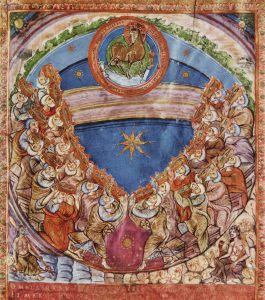
Sermon Notes
Text: Revelation 12:1-6
Proposition:
God’s saving power is greater than the power of all who oppose him, including the Devil.
Alternate: We can trust in God’s saving power.
I. Introduction
Revelation is not just about future events. It also contains a lot of information that is relevant for the Christian’s view of the world in the present and for the Christian life. We seldom study beyond Revelation 1-3 and 21-22, because the book requires some work in order to figure out how to interpret it correctly.
II. The Woman (Rev 12:1-2)
A. How to interpret the book of Revelation. The primary source for the images of the book of Revelation is the Old Testament. Sometimes Revelation simply borrows those images and builds upon them, but sometimes Revelation adapts those images in interesting ways. We see both of these in the case of the Woman and the Dragon.
B. Revelation 12:1. Who is the woman? What do we learn about her?
1. Read Genesis 37:9-10
2. The woman represents Israel. As Revelation 12:5-6 makes clear, the woman does not represent all of Israel. Rather, she represents the part of Israel that will receive Jesus as her Messiah. Another way to say this would be that she represents those from faithful Israel who are longing for the coming of the Messiah. Remember that the first disciples, and especially the 12, were Jews who received Jesus as their Messiah (Note: This is not Mary—think bigger!).
C. Why is she in pain? The woman’s pains of childbirth are the pains of her overthrow, exile, and oppression under the power of foreign rulers and the Devil (the ruler of this world in John 12:31). The birth of the Messiah will mean deliverance for her. The woman of Revelation 12:2 fulfills the expectations of Micah 5:3 (see Micah 4:6-5:5). Her pains are the pains that God’s people have been suffering, as they have anticipated the coming of their Messiah and Savior, Jesus.
III. The Dragon (Rev 12:3-4)
A. Revelation 12:3. Who is the Dragon? What do we learn about him?
1. In order to understand the Dragon, we need to look once again to the Old Testament. The image of the Dragon is complex, so we cannot look at all of the related OT texts during our time together.
2. The name Dragon is a translation of the related Greek term drakōn (δράκων). In the Greek translation of the OT, this term can mean serpent or it can refer to a great sea monster, including the creature known as “Leviathan.” These great sea monsters are opposed to God and his people.
3. Two of the great rulers who oppress God’s people are referred to as dragons. Pharaoh, ruler of Egypt, is one and Nebuchadnezzar, ruler of Babylon, is the other (see note 1). These references are interesting, because Satan is the ruler of the world (John 12:31). As such, he and the Beast are the power behind the world’s rulers who oppress God’s people. The Dragon and the Beast are the rulers who oppress God’s people in Revelation 12 and 13. The Dragon of Revelation 12 oppresses God’s people, as Pharaoh did at the time of the Exodus. The Pharaoh connection seems relevant, because Revelation 12 contains many instances of Exodus typology.
B. Seven heads
The Dragon’s seven heads and seven crowns portray him as a ruler whose authority to rule is like the authority of God. Seven is the number of God in Revelation. God’s ruler, the Lamb, has seven horns (5:6) and many crowns (19:12). One of the repeated themes of Revelation 12-13 is the unholy trinity’s attempts to imitate God and pretend to be his equal. John interprets the Dragon’s seven heads and ten horns in Revelation 17:9-13.
C. Revelation 12:4. What is the Dragon attempting to do? He is preparing to devour the child of the woman.
IV. The Child (Rev 12:5)
A. Rev 12:5a. Who is the child? Read Psalm 2:2, 9. He is the Messiah. The child is also the seed of the woman who will oppose the serpent (read Gen 3:15). If the woman’s child will mean a new Davidic king and deliverance for God’s people, then her oppressors would certainly want to do away with her child. The fiery Dragon of Revelation 12:3-4 is her chief oppressor. As we will see in Revelation 12-13, he is the one who incites the people of the world against the woman and her children.
B. Rev 12:5b. God thwarts the Dragon by snatching the woman’s child from his reach and delivering him to the ultimate place of safety. These words refer especially to Jesus’ resurrection and exaltation to take his place on God’s throne. They anticipate the announcement of Christ’s reign in 12:10.
C. Application. Let’s step back and review. What kind of picture is John painting here? What does this picture tell us about the power of God and about the power of the Devil? What is the good news here for us and for our world? Close with John 16:33.
V. The Dragon Pursues the Woman (Rev 12:6)
A. After the child’s birth, the woman represents the church in its infancy (12:6, 13-16).
B. Having failed to kill her child, the Dragon will turn his attention to the woman, so she flees into the wilderness where God cares for her for 1,260 days or 3½ years.
C. Revelation 12:6 anticipates 12:7-17.
Note 1: Ezek. 29:3; 32:2 (Pharaoh); Jer. 51:34 (Nebuchadnezzar). Ps. 74:14; 89:10 and Isa. 51:9 appear to refer to Egypt as a sea monster (see Isa. 30:7). See Beale, Revelation, 632-3; Beasley-Murray, Revelation, 198; Caird, Revelation, 150. Psalms of Solomon 2:25 is following the OT precedent when it refers to Pompey (a Roman) as a dragon when he conquers Jerusalem (see Caird, Revelation, 150).
